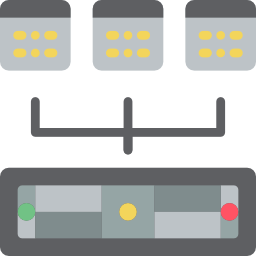
KVM Switch – Network Hardware Components
A KVM switch, short for Keyboard, Video (monitor), and Mouse switch, is a hardware device that allows a user to control multiple computers using a single keyboard, monitor, and mouse setup. It is especially useful in environments where space, efficiency, and centralized control are critical. KVM switches are considered part of both peripheral and network-related hardware components due to their role in managing physical connections and facilitating access between multiple systems.
This device is commonly used in data centers, server rooms, and professional workstations where managing multiple computers simultaneously is necessary. By reducing the need for multiple sets of input/output devices, a KVM switch enhances organization and streamlines operations.
Applications and Functions of KVM Switches
Managing multiple computers or servers from a single user console
Facilitating remote access and control in server environments
Reducing hardware clutter and simplifying workspace configurations
Enhancing security by allowing systems to be isolated physically while still being accessible
Supporting IT maintenance tasks without requiring physical movement between systems
Used in production environments, control rooms, and broadcasting facilities
Useful for testing environments where multiple machines are needed for software or hardware tests
Employed in educational and training labs for managing multiple PCs from a central station
Ideal for offices or businesses with limited desk space that still require access to several machines
Integrated into enterprise infrastructure for quick switching and monitoring of various systems
Types of KVM Switches
Basic KVM Switches: Allow manual switching between a small number of connected computers using buttons or keyboard shortcuts
USB KVM Switches: Utilize USB ports for connectivity and support modern peripherals
HDMI or DisplayPort KVM Switches: Support higher video resolutions and are suitable for advanced display systems
IP-Based KVM Switches: Allow remote access and control over a network, often used in large-scale data centers
Dual-Monitor or Multi-Monitor KVMs: Designed for systems that use more than one display
Secure KVM Switches: Built to meet government and industry security standards, used in high-security environments
Key Features and Capabilities
Single set of peripherals controls multiple computers
Manual or automatic switching between systems
Support for audio, USB peripherals, and even file transfer in advanced models
Compatibility with different operating systems and hardware platforms
Compact physical design for desktop or rack mounting
Remote access capabilities through IP-based models
High-resolution video support for modern display requirements
Secure switching to prevent data leakage between systems
Cost and Accessibility
KVM switches are commercial hardware devices, and their use is not free. The price of a KVM switch varies based on its type, number of ports, supported video resolutions, remote access features, and security compliance. Entry-level KVM switches with two ports and basic functionality are relatively inexpensive and accessible for home users or small offices. On the other hand, enterprise-grade models with IP access, secure switching, and multi-monitor support can be significantly more expensive.
Organizations often view the cost of KVM switches as an investment in efficiency, reducing the need for duplicate hardware and improving workflow. In some managed IT setups, KVM switches can also help reduce downtime and support costs. However, for individual users with limited needs, the added cost may not be necessary unless multiple systems are used regularly.
Comparison with Alternative Solutions
Compared to using multiple sets of keyboards, monitors, and mice, KVM switches offer clear advantages in terms of space-saving, cost efficiency, and simplified control. Software-based remote desktop solutions can also allow access to multiple machines, but they depend on network connectivity and may introduce latency or security concerns. In contrast, a KVM switch provides direct hardware-level control, which is faster and more secure.
IP-based KVM switches offer more flexibility than local-only models by enabling remote control, but they also require more configuration and higher upfront investment. Secure KVM switches are designed to prevent data leakage between networks or classified systems, unlike software KVMs, which are more vulnerable to attacks and unauthorized access.
While software solutions may offer some similar capabilities, they cannot fully replace the reliability and performance of a physical KVM switch, especially in professional or high-security environments.
Conclusion
A KVM switch is a valuable piece of network-related hardware that simplifies the management of multiple computers by allowing control through a single set of peripherals. It plays a vital role in server rooms, control centers, and professional workspaces where efficiency, security, and centralized access are essential. Although not free and dependent on the model and functionality, KVM switches offer cost-effective benefits in the long term by reducing hardware redundancy and improving workflow. Their hardware-level reliability and performance make them indispensable in environments where remote software solutions may fall short. As technology continues to evolve, KVM switches remain a trusted solution for multi-system management and centralized access control.












